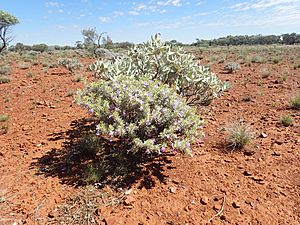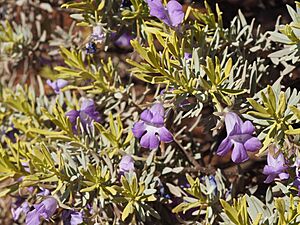Eremophila citrina facts for kids
Quick facts for kids Eremophila citrina |
|
|---|---|
 |
|
| Eremophila citrina growing about 94 km south of Newman | |
| Scientific classification | |
| Genus: |
Eremophila (plant)
|
| Species: |
citrina
|
Eremophila citrina is a beautiful flowering plant that belongs to the figwort family, called Scrophulariaceae. It grows only in the middle of Western Australia. This plant is a thick, round bush with bright yellow new leaves. It has many leaves close together and pretty lilac or light purple flowers.
Contents
What Eremophila citrina Looks Like
Eremophila citrina is an upright, bushy plant. It usually grows about 1 m (3 ft) tall and nearly as wide. Its new leaves and stems are covered with tiny, lemon-colored hairs. These hairs are called glandular hairs because they can produce sticky stuff. Over time, these hairs change to a grey color.
The leaves grow one after another along the stems. They are thick and grow close together. You can usually see a clear line, called a mid-vein, on the bottom of the leaves. The leaves are long and narrow, shaped like a spear or a narrow egg. Most are about 14–25 mm (0.6–1 in) long and 2–4 mm (0.08–0.2 in) wide.
The flowers grow one by one where a leaf meets the stem. Each flower has a straight stalk about 7–11 mm (0.3–0.4 in) long. There are five green to purple-brown sepals, which are like small leaves that protect the flower bud. They are mostly 10–18 mm (0.39–0.71 in) long and covered with yellowish hairs, especially when new.
The petals are 18–30 mm (0.7–1 in) long and join together at the bottom to form a tube. The outside of this tube is light purple or lilac. The inside is white with light purple spots. The outside of the tube is smooth, meaning it has no hairs, except for the ends of the petals, which are hairy. The inside of the petal ends are smooth, but the tube itself is full of long, soft hairs.
This plant usually flowers from June to October, especially after it rains. After flowering, it grows fruits. These fruits are oval or almost round. They have a papery covering and are about 6 mm (0.2 in) long.
How Eremophila citrina Got Its Name
The plant was first officially described by a scientist named Robert Chinnock in 2007. He wrote about it in a book called Eremophila and Allied Genera: A Monograph of the Plant Family Myoporaceae. The first plant specimen used to describe the species, called the type specimen, was collected by Chinnock near Minga Bore.
The second part of the plant's scientific name, citrina, is a Latin word. It means "from a lemon tree." This name was chosen because the new growth of this plant is a bright lemon-yellow color.
Where Eremophila citrina Grows
Eremophila citrina can be found in a wide area between the towns of Newman and Laverton. It likes to grow in rocky soil that comes from a type of rock called laterite.
Is Eremophila citrina Endangered?
The Government of Western Australia's Department of Parks and Wildlife says that Eremophila citrina is "not threatened." This means there are enough of these plants in the wild, and they are not in danger of disappearing.
Growing Eremophila citrina in Gardens
This type of eremophila is not very well known in gardens yet. However, it grows well on a property in western Victoria. Its bright golden new leaves and purple or lilac flowers make it a very attractive plant.
Gardeners have grown these plants by grafting them onto Myoporum plants. Grafting is when you join parts of two plants so they grow as one. Eremophila citrina grows best in soil that drains water well and in a sunny spot. However, it does not like frost and can be damaged by it.


